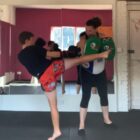How to get back into training
Exercise and living a healthy lifestyle is so important for mental and physical health. If you have struggled to maintain a fitness routine, have taken some time off due to illness, or injury, you may feel like you have no idea where to start. Below are some simple tips which you can follow so your workouts don’t seem too daunting!
- Let go of the guilt – remember that losing motivation is normal! There is absolutely no point of holding your past against you – let’s learn from the past in order to move forward with determination and a positive mind set.
- Make healthy habits that are going to last. You will not stick to a routine that you hate. Find an exercise that you LOVE to do, that doesn’t feel like a chore… then subconsciously it will develop into a habit.
- Commit to training with a friend, join a gym, or go to a fitness class. Have somebody that will keep you accountable…cut the excuses and start believing in yourself that you can make a change!
- Plan your workouts and schedule them into your diary, if they’re scheduled in you are less likely to skip them!
- Try a challenge…… Find something that will keep your engaged and interested. Signing up to a challenge will fulfil that sense of achievement and accomplishment.
- Don’t push yourself too hard, too soon. Stick to a progressive programme that allows you to see your improvements and celebrate them, without setting yourself up for failure.








